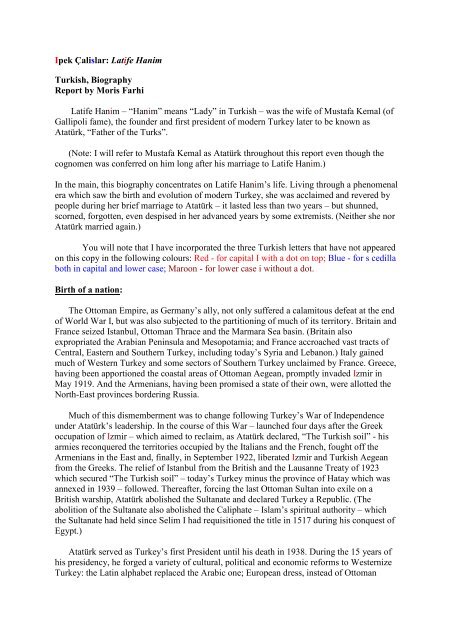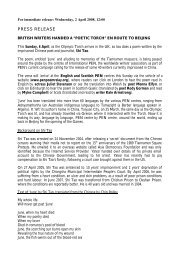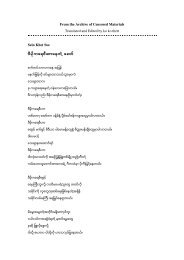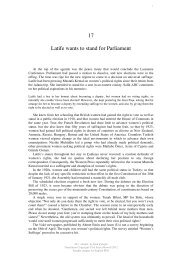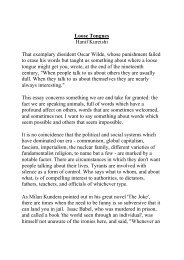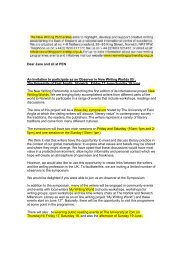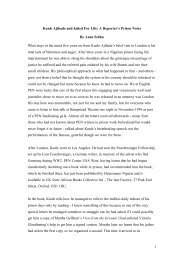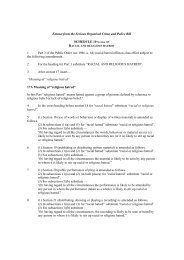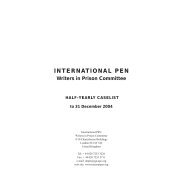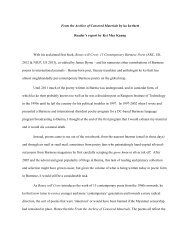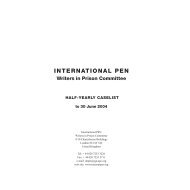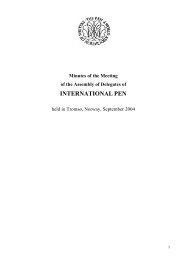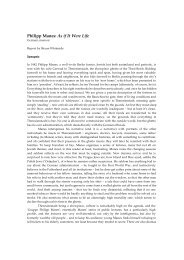Ipek Ãalislar: Latife Hanim Turkish, Biography Report ... - English PEN
Ipek Ãalislar: Latife Hanim Turkish, Biography Report ... - English PEN
Ipek Ãalislar: Latife Hanim Turkish, Biography Report ... - English PEN
- No tags were found...
You also want an ePaper? Increase the reach of your titles
YUMPU automatically turns print PDFs into web optimized ePapers that Google loves.
<strong>Ipek</strong> Çalislar: <strong>Latife</strong> <strong>Hanim</strong><strong>Turkish</strong>, <strong>Biography</strong><strong>Report</strong> by Moris Farhi<strong>Latife</strong> <strong>Hanim</strong> – “<strong>Hanim</strong>” means “Lady” in <strong>Turkish</strong> – was the wife of Mustafa Kemal (ofGallipoli fame), the founder and first president of modern Turkey later to be known asAtatürk, “Father of the Turks”.(Note: I will refer to Mustafa Kemal as Atatürk throughout this report even though thecognomen was conferred on him long after his marriage to <strong>Latife</strong> <strong>Hanim</strong>.)In the main, this biography concentrates on <strong>Latife</strong> <strong>Hanim</strong>’s life. Living through a phenomenalera which saw the birth and evolution of modern Turkey, she was acclaimed and revered bypeople during her brief marriage to Atatürk – it lasted less than two years – but shunned,scorned, forgotten, even despised in her advanced years by some extremists. (Neither she norAtatürk married again.)You will note that I have incorporated the three <strong>Turkish</strong> letters that have not appearedon this copy in the following colours: Red - for capital I with a dot on top; Blue - for s cedillaboth in capital and lower case; Maroon - for lower case i without a dot.Birth of a nation:The Ottoman Empire, as Germany’s ally, not only suffered a calamitous defeat at the endof World War I, but was also subjected to the partitioning of much of its territory. Britain andFrance seized Istanbul, Ottoman Thrace and the Marmara Sea basin. (Britain alsoexpropriated the Arabian Peninsula and Mesopotamia; and France accroached vast tracts ofCentral, Eastern and Southern Turkey, including today’s Syria and Lebanon.) Italy gainedmuch of Western Turkey and some sectors of Southern Turkey unclaimed by France. Greece,having been apportioned the coastal areas of Ottoman Aegean, promptly invaded Izmir inMay 1919. And the Armenians, having been promised a state of their own, were allotted theNorth-East provinces bordering Russia.Much of this dismemberment was to change following Turkey’s War of Independenceunder Atatürk’s leadership. In the course of this War – launched four days after the Greekoccupation of Izmir – which aimed to reclaim, as Atatürk declared, “The <strong>Turkish</strong> soil” - hisarmies reconquered the territories occupied by the Italians and the French, fought off theArmenians in the East and, finally, in September 1922, liberated Izmir and <strong>Turkish</strong> Aegeanfrom the Greeks. The relief of Istanbul from the British and the Lausanne Treaty of 1923which secured “The <strong>Turkish</strong> soil” – today’s Turkey minus the province of Hatay which wasannexed in 1939 – followed. Thereafter, forcing the last Ottoman Sultan into exile on aBritish warship, Atatürk abolished the Sultanate and declared Turkey a Republic. (Theabolition of the Sultanate also abolished the Caliphate – Islam’s spiritual authority – whichthe Sultanate had held since Selim I had requisitioned the title in 1517 during his conquest ofEgypt.)Atatürk served as Turkey’s first President until his death in 1938. During the 15 years ofhis presidency, he forged a variety of cultural, political and economic reforms to WesternizeTurkey: the Latin alphabet replaced the Arabic one; European dress, instead of Ottoman
attire, not least for women, became law as did the accretion of surnames; the sharia wasabrogated and substituted with legislation based on Swiss laws; and, remarkably, the statutethat declared Turkey a secular state became one of the pillars of the constitution. (To this day,for most Muslim countries, the concept of a secular state is unthinkable, if not intolerable.The same can be said of many Christian states.) Thus, under Atatürk’s rule Turkey rose fromthe ashes of the Ottoman Empire and set out to transform itself from the undeveloped,theocratic, regressive “sick man of Europe” into a vibrant, westernized country.Synopsis:<strong>Latife</strong> <strong>Hanim</strong> – maiden name: <strong>Latife</strong> Usakizade, married name: <strong>Latife</strong> Mustafa Kemaland, after her divorce, given the surname of Ussaki by Atatürk himself – was born in 1898 toone of Izmir’s richest families. Her father, a merchant much influenced by the West and wellknownin Europe and the USA, provided his children with the best education possible. Thus<strong>Latife</strong> became an accomplished pianist, spoke the languages prevalent in the then open-portof Izmir – French, Italian, Ladino, Greek, <strong>English</strong> – and pursued higher studies inChislehurst, England, and law in the Sorbonne in Paris. Consequently, by the time she metAtatürk on September 11, 1922, she was a lively, enlightened young woman much engrossedwith women’s rights.Atatürk reached Izmir soon after its liberation. As the remnants of the defeated Greekarmy desperately fled by sea, a ferocious fire – probably started by the Turks – raged andconsumed vast tracts of the city.<strong>Latife</strong> who, captivated like most Turks by Atatürk’s fame and hero-worshipping him as“Turkey’s Saviour”, went to meet him to offer him her family’s mansion, located in a districtuntouched by the fire, as his headquarters. Atatürk accepted the offer.<strong>Latife</strong> proved to be the perfect hostess during the three weeks he billeted there. His charm,striking looks and exemplary good manners soon transformed her hero-worship into love.Atatürk, in turn, though feverishly engaged in supervising Cease-Fire negotiations, wasenthralled by her education, polyglottism, intelligence, high spirits and, not least, by herviews on women’s emancipation – views which he shared and which would be one of hismain reforms in patriarchal Turkey. At times, he even consulted her on certain matters ofstate or asked her to help draft important messages in <strong>English</strong>.By the end of his stay, deciding that she would be the perfect consort for him – as well asan invaluable helpmate in rebuilding Turkey – he proposed to her.On September 29, 1922, overriding <strong>Latife</strong>’s requests to accompany him and telling her hewould summon her soon, he left for Ankara, his proposed capital for the new Turkey, toattend to pressing political matters. (One reason that hindered Atatürk from taking <strong>Latife</strong> withhim might have been the presence in Ankara of Fikriye <strong>Hanim</strong>, his long-time mistress whomhe no longer favoured but from whom he had not yet separated. This he did when he sentFikriye – who was ill with tuberculosis – to Munich for treatment.)On January 27, 1923, soon after his mother, Zübeyde <strong>Hanim</strong>’s death, Atatürk returned toIzmir to marry <strong>Latife</strong>. (Though Zübeyde <strong>Hanim</strong> had approved of her son’s marriage to <strong>Latife</strong>,<strong>Latife</strong>’s father, Muammer, had advised against it.)
The marriage took place on January 29, 1923.This was a time when the Lausanne Peace Treaty negotiations and plans to declareTurkey a republic were primary concerns. (The Lausanne Treaty was signed on July 24, 1923and on October 29, 1923 the Grand National Assembly which had been elected in 1920 onAtatürk’s appeal but had since been overhauled as the new parliament, proclaimed Turkey arepublic.)The marriage started harmoniously. Atatürk, eager to embark on his reforms, set anexample for the emancipation of women by touring parts of Turkey – with <strong>Latife</strong> prominentlyat his side – in lieu of a honeymoon.The people in those regions, charmed by <strong>Latife</strong> – who was always dressed in smart, butmodest, European clothes – took her to their hearts.Back in Ankara, <strong>Latife</strong>’s popularity increased through her visits to the nascent Parliamentwith Atatürk, her candid interviews with journalists from various countries and her cordialmeetings with foreign dignitaries. Almost without exception, she was lauded as an irresistiblycharming woman with a fine intellect and political acumen.<strong>Latife</strong>’s love toward Atatürk deepened day by day. By now even more convinced that hewas “Turkey’s Saviour”, she felt gratified that he included her in his activities and at hisdinners with old comrades-at-arms and important personages. (At times, he even rehearsedhis speeches by reading them out loud to her.)But she also worried about Atatürk’s health – particularly about his smoking and heavydrinking with his cronies long into the night – and tried to curtail his excesses. Her concernsfor his health increased when, soon after the birth of the Republic, he suffered a heart attack.She nursed him back to health devotedly.(She proved the depth of her love, her affirmation that she would die for him, on twooccasions.On the first, in April 1923, when Topal Osman, the leader of a militia, having murdereda member of the Grand National Assembly, surrounded their residence with his men andfusilladed Atatürk’s room, she improvised Atatürk’s escape by dressing him in her clothes;then to give the impression that Atatürk was still in the room, she put on his hat and stood ona crate of oranges by the window. Entering the residence eventually, Topal Osman, seeingthat Atatürk had escaped, ransacked the place and manhandled <strong>Latife</strong>. He was later arrestedand killed.On the second, in January 1924, an unknown man, said to be from Crete, having beengranted an audience, attempted to assassinate Atatürk by throwing a bomb. <strong>Latife</strong>, trying toshield Atatürk, was slightly wounded in the process. Though the man was apprehended, theincident was kept secret from <strong>Turkish</strong> journalists and was reported only in foreign media.)After some months, <strong>Latife</strong>’s deep love commuted into possessive love. Her status asAtatürk’s consort and aide fuelled her sense of self-importance.Eventually possessive love tinged with hubris brought on resentments. She begrudged
Atatürk’s dinner-and-drinks parties with old comrades and felt excluded. She was gravelyoffended when he refused to allow her to stand for parliament as well as when he disapprovedof her support for the newly-formed Women’s Party and other fledgling parties. She becamejealous when he was attentive to other people, particularly women. (This jealousy may havebeen fuelled when Fikriye <strong>Hanim</strong>, Atatürk’s former lover, having returned from Germany,visited him at the presidential residence. <strong>Latife</strong> met her during her first visit and found herunlikeable. On her second visit, Fikriye, failing to receive an audience with Atatürk, left thepresidential residence in a huff, then shot herself in her carriage; she died two days later. Ithas been assumed that on this second visit Fikriye had the intention of murdering bothAtatürk and <strong>Latife</strong> before killing herself.)Though there appeared to be a hiatus in <strong>Latife</strong>’s moods when she accompanied Atatürkon a tour of Eastern Turkey, this proved very brief. At Sarikami s irked by Atatürk’s praisefor their hostess, she threw another tantrum, even challenged him to divorce her. Atatürk,infuriated by the incident and despite <strong>Latife</strong>’s subsequent pleas for forgiveness, began toconsider that possibility.Finally, following another of her outbursts against his drinking companions, Atatürkwrote a letter to <strong>Latife</strong> on July 22, 1925, suggesting that she should go away for a while toIstanbul or Izmir for “treatment”. Feeling desolate, but thinking that this would only be atemporary separation, <strong>Latife</strong> left for her family home in Izmir.But her hopes proved delusional. On August 12, 1925, Atatürk divorced her with agovernmental directive. This was a rushed and unexpected procedure that mirrored Ottomanprocedures. One reason given as mitigation for the haste was that as the new civil law had notyet been passed by the Parliament the particular directive was the only law applicable. (Thenew civil law was ratified about a year later.)The divorce rendered <strong>Latife</strong> inconsolable. (It also harmed the family’s prestige in Izmir,inducing them to move to Istanbul.) Self-recrimination – including, as she put it, “herinability” to give Atatürk a child – dominated much of the early years. By all accounts,Atatürk, too, deplored the disunion and was much saddened by it.(After the divorce <strong>Latife</strong> and Atatürk met only once – from a distance. Yet throughouttheir separate lives, both remained considerate, even “loving” toward each other. Quiteundoubtedly both had sworn never to disclose matters concerning their conjugal life and keptthis promise. <strong>Latife</strong> who outlived Atatürk for almost forty years, not only observed thisfidelity until her own death, but also instructed those family members who survived her tofollow her example.Atatürk died on November 10, 1938. At the time <strong>Latife</strong> was having treatment in ahospital in Bern, Switzerland. The news left her desolate.During the ensuing years, <strong>Latife</strong> spent much of her time in seclusion, seeing onlymembers of her family and her old friends. Of the latter the most notable was Ismet Inönü,Atatürk’s best general during the War of Independence and his successor as President.Sorrow continued to be ever-present in her life as she lost beloved members of her family,including her parents.Atatürk’s death prompted many publications, mainly memoirs. Most of these idolized
him. However, some publications in the 1950s, haunted by the “possibility” that <strong>Latife</strong> mightbe persuaded to divulge the real dynamics of her marriage and thus mar Atatürk’s iconicimage, blamed <strong>Latife</strong> <strong>Hanim</strong> for the failure of their marriage by relating certain contentiousincidents that had become public knowledge. These publications, despite <strong>Latife</strong>’s continuedsilence about her life with Atatürk, unleashed a condemnatory campaign against her. Thoughshe found this campaign hurtful and malign, she refused to break her silence.<strong>Latife</strong> <strong>Hanim</strong> died on July 12, 1975 of cancer.She left numerous writings and documents in two safe deposit boxes in two separateIstanbul banks. Her family bequeathed the contents of these boxes to the <strong>Turkish</strong> HistoricalInstitute. Though the boxes were duly opened, respectively, in 1977 and 1979, a considerablenumber of their contents – letters and documentation that would shed important light onTurkey’s recent history – were returned to the Historical Archives and still awaitdeclassification.Summary of Chapters:(As this book comprises 41 chapters and 5 addenda, I will summarize them in groups.)Chapters 1-5:Introduction to <strong>Latife</strong>’s childhood and youth, her rich family, her privileged backgroundand her exceptional education.<strong>Latife</strong>, who, during the Greek occupation of Izmir was with her family abroad, is the firstto return to Turkey. She is present in Izmir when the city is liberated by Atatürk’s forces.As a great fire rages in Izmir, she goes to meet Atatürk and offers him the family mansionfor his headquarters. Atatürk accepts the offer.He stays in Izmir for three weeks. During that time, he is captivated by <strong>Latife</strong>’s charm,intelligence and views on world affairs. Before leaving for Ankara, he proposes marriage.<strong>Latife</strong> accepts.Chapters 6-8:Anxiously <strong>Latife</strong> waits to be summoned to Ankara.But Atatürk has a heavy schedule. He also has to end his relationship with his ladyfriend, Fikriye <strong>Hanim</strong>. This he does by sending her to Munich to be treated for tuberculosis.Atatürk’s mother, Zübeyde <strong>Hanim</strong> develops health problems.Nonetheless, she goes to Izmir to meet <strong>Latife</strong>. <strong>Latife</strong> looks after her devotedly. Zübeyde<strong>Hanim</strong> approves of her as daughter-in-law. <strong>Latife</strong>’s engagement to Atatürk is announced.Zübeyde <strong>Hanim</strong> dies on January 15, 1923.Chapters 9-13:
Atatürk reaches Izmir a week after his mother’s death.He and <strong>Latife</strong> marry two days later on January 29, 1923.A small tour of Anatolia and meetings about the future of Turkey, particularly with theteam negotiating the Lausanne Peace Treaty, serves as their honeymoon.The people they meet, particularly the women, are much impressed by <strong>Latife</strong>.They return to Ankara – at the time a gloomy, poverty-stricken town – and settle downin a run-down mansion on the heights.<strong>Latife</strong>, dipping into her dowry, repairs and embellishes the mansion.This being a period of intense political activity, she meets many important personagesand visits the Grand National Assembly.Her presence in Ankara intrigues the world media. They eulogize her in their writings.Chapters 14-16:<strong>Latife</strong> accompanies Atatürk on a tour to Southern Turkey.Smartly dressed in European attire. she endears herself to the people, particularly thewomen.On their return, Topal Osman, leader of a militia that served as Atatürk’s bodyguards,having murdered a member of the Grand National Assembly, chooses to resist arrest. Hesurrounds the mansion with his cohorts and fusillades Atatürk’s room.<strong>Latife</strong> improvises Atatürk’s escape by dressing him in her clothes, then puts on his hatand stands on a crate of oranges by the window to give the impression that Atatürk is still inthe room.When Topal Osman enters the mansion and sees that Atatürk has escaped, he ransacksthe place and manhandles <strong>Latife</strong>.Chapters 17-20:As the signing of the Lausanne Peace Treaty looms ahead, steps are taken to form a newparliament.<strong>Latife</strong>, by then much involved with women’s rights, seeks to stand as a candidate for aneastern seat. But Atatürk, though in favour of women’s suffrage, does not see fit that his wifeshould stand for parliament.In the elections, <strong>Latife</strong> and a number of women from the nascent Women’s party receivesome votes. But this is a Pyrrhic victory: women are still excluded from politics.
The Lausanne Peace Treaty is signed on July 24, 1923.On October 29, 1923, the Republic is proclaimed. The Parliament elects Atatürk asPresident.Stressed by the eventful months, Atatürk suffers two heart attacks.Chapters 21-24:On January 1924, during a restorative visit to Izmir, an unknown man, having beengranted an audience, attempts to assassinate Atatürk. <strong>Latife</strong>, trying to shield Atatürk, isslightly wounded.The incident and the would-be assassin’s identity, kept secret from the <strong>Turkish</strong> press, isnonetheless reported by foreign media.Atatürk’s dinner parties become a forum. His drinking late into the night with closefriends makes <strong>Latife</strong> feel excluded. She also worries about Atatürk’s health.Chapters 25-27:Toward the end of May, 1924, Fikriye, Atatürk’s former lady-friend, reappears inAnkara.<strong>Latife</strong> meets Fikriye on Fikriye’s first visit but does not like her. She also shows signs ofjealousy.On her second visit, Fikriye, having failed to have an audience with Atatürk, attempts tocommit suicide. She wounds herself fatally and dies two days later.Atatürk inaugurates the first <strong>Turkish</strong> bank.At the end of August 1924, Atatürk and <strong>Latife</strong> go on a long tour of Turkey.At first, harmony prevails. People receive them joyously.<strong>Latife</strong> is much affected by the poverty in the country and the devastation caused byearthquakes. She gets impatient with Atatürk, particularly of his bonhomie toward hisentourage. The tension between them rises.Chapters 28-30:The newly created Progressive Republican Party sets up in opposition to Atatürk’s party.As this new party promises women’s suffrage, <strong>Latife</strong> praises its policies.On February 13, 1925, the Kurdish Sheikh, Seyh Said, rebels and captures the easterncities of Elazig and Diyarbakir. Draconian laws are passed and the rebellion is quelled. Onthe assumption that the rebellion had the Progressive Republican Party’s support, many of itsmembers are arrested and the party is dissolved.
During these events <strong>Latife</strong> receives many honours and becomes the Honourary Presidentof the <strong>Turkish</strong> Hearth – a cultural nationalist organization. (Note this organization wasincorporated into Atatürk’s party, the CHP, in 1931.)But the disharmony between <strong>Latife</strong> and Atatürk prevails.After another of <strong>Latife</strong>’s tantrums, Atatürk decides to divorce her. He sends her to herfamily home in Izmir, then, on August 12, 1925, divorces her with a governmental directive.Chapters 31-33:The divorce – and its Ottoman procedure – evokes perplexed international reaction.Some journalists compare the <strong>Latife</strong>-Atatürk relationship with that of Josephine andNapoleon.Chapters 34-36:<strong>Latife</strong>, full of remorse, is inconsolable and remains so.Atatürk, too, appears to deplore the situation.Most honourably, neither she nor he speak ill of each other throughout their lives.Though <strong>Latife</strong>, after meeting Napoleon’s famous biographer, Emil Ludwig, does confide inLudwig, she forbids him to publish the story of her life.Chapters 37-41:The latter half of <strong>Latife</strong>’s life passes in semi seclusion. Living in the family home inIstanbul, she sees only members of her family and her old friends.But her interest in women’s suffrage continues and she eventually sees the day when awoman is elected to the Parliament.Another tragedy strikes her when her sister, Münci, dies in mystifying circumstancesover a love affair.<strong>Latife</strong> receives the surname Ussaki – which meaning “those in love” is a pun on herfamily name, Usakizade – directly from Atatürk.Atatürk dies on November 10, 1938.<strong>Latife</strong> hears the news while having treatment in a hospital in Bern, Switzerland.Desolate, she becomes even more reclusive.In the 1950s extremists launch a campaign to blacken her name. Much as this hurts andoffends her, she keeps her promise to Atatürk and never discloses anything about theirconjugal life.
In the 1960s she moves to a small apartment.She dies there of cancer on July 12, 1975.She leaves two safe deposit boxes in two different banks. These contain her personaleffects, letters and writings.Addenda 1-5:These addenda draw attention to the contents of the safe deposit boxes which <strong>Latife</strong>’sfamily bequeathed to the <strong>Turkish</strong> Historical Foundation.They were opened respectively, in 1977 and 1979.Some personal items were returned to the family or sent to the Military Museum.Some letters and writings, already in the public domain, were released.But a considerable number of letters, writings and documentation that would shedimportant light on Turkey’s recent history were sealed and returned to the HistoricalArchives. They still await declassification.<strong>Report</strong>:This is a meticulously researched work that must have examined every available source.In the best tradition of biographical works, the author not only focuses on <strong>Latife</strong> <strong>Hanim</strong>’spersona, but also explores her anima. Abreast with this endeavour, there are notable insightsinto Atatürk – the real person as opposed to the deified figure he has become for most Turks.Moreover, there are pertinent references, albeit compressed, to some of the importanthistorical events that occurred during Turkey’s birth and development.(Some readers might feel disappointed by the compression of some of the historicalevents – such as the assassination attempts on Atatürk and the Seyh Said rebellion – andhanker for more information. This can be remedied easily.) (See EDITORIALRECOMMEDATIO II.)Then again it should be borne in mind that the author has not set out to write a historicaltreatise, but to provide – despite the unavailability of some important documentation – ascomprehensive a biography of <strong>Latife</strong> as possible. That said, the fact that this biographyrecounts the life of an exceptional woman, briefly married to a pre-eminent statesman andliving in extraordinary times, elevates the work as a unique historical document. Indeed,<strong>Latife</strong> <strong>Hanim</strong> should appeal to publishers as an important reference work, a companion to thetwo major biographies of Atatürk, both published to great acclaim, by Lord Kinross andAndrew Mango.
If I may, I will take the liberty of suggesting two editorial recommendations.I.Given <strong>Ipek</strong> Çalislar’s exhaustive research, the book is saturated with the personages thattouched <strong>Latife</strong>’s life. Most of these personages would be unfamiliar to the Anglophonereadership as, I imagine, the personages of Churchill’s War Cabinet would be unfamiliar tomost non-British readers. I would, therefore, suggest that the personages in <strong>Latife</strong> <strong>Hanim</strong>should be listed as an Appendix with brief mentions of their identity and/or status. (And ifpossible some of the minor ones should be omitted.)II:<strong>Latife</strong> <strong>Hanim</strong> has a profusion of footnotes which cite the source/s of the given text. Iwould suggest that these footnotes can be dispensed with or, should the author insist,transferred to a second Appendix.This would enable the publisher to insert far more important footnotes, namely, moredetailed accounts of those important historical events that, at present, are compressed. Thismeasure should satisfy those readers who prefer a larger historical perspective.Recommendation:I would recommend the publication of this book. It not only brings to life anextraordinary woman, but also serves as a unique historical document. My concern is that,given its length, many publishers might hesitate to take it on. However, I believe the authorand the translator are in the process of abridging it. That would be a very favourable move.MORIS FARHIJanuary 7, 2012.Commissioned by Writers in Translation, <strong>English</strong> <strong>PEN</strong>


